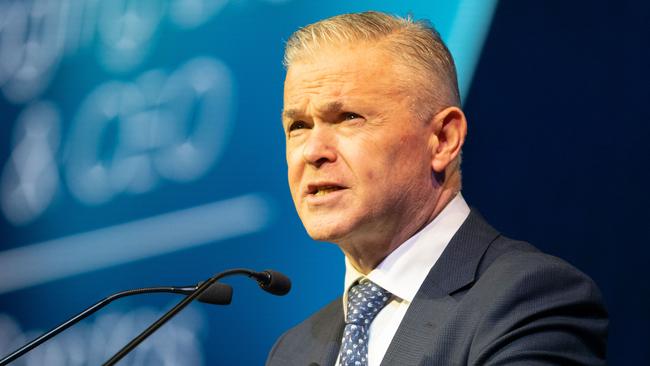Santos boss Kevin Gallagher says gas is the key to moving to net zero, not renewables
Santos managing director Kevin Gallagher says renewables are not the holy grail, as Peter Dutton calls on the industry to stand up and fight.
Gas, not renewable energy, is the “main game” in the transition to net zero, Santos managing director Kevin Gallagher says, while warning the industry’s opponents are focused on “killing oil and gas”.
Speaking at the Australian Petroleum Production and Exploration Association conference in Adelaide on Thursday, Mr Gallagher also championed carbon capture and storage (CCS) as integral to the transition, saying Santos’s Moomba project would equate to the carbon impact of taking 200,000-300,000 cars off the road.
Mr Gallagher said Santos was not looking for a government handout for its CCS ambitions, which include three hubs starting with the $US165m Moomba CCS project that aims to start injecting CO2 next year.
But the industry did need “a supportive regulatory framework’’ to be able to move forward with confidence, he said.
Mr Gallagher said “abated oil and gas” was crucial to the move to net zero, with CCS a vital part of the equation.
He also said gas was at the core of the long-term shift to net zero, while downplaying the role of renewables.
“Renewables are part of the solution, but they are not the holy grail,’’ he said.
“The main game is gas because it makes renewables possible, it provides feedstock for fertilisers and chemicals, and it fires the high temperature furnaces required for bricks and cement.
“However, while getting to net zero should be all about emissions reductions, our opponents are only about killing oil and gas. Which is why they now seek to discredit carbon capture and storage as well.’’

The conference being held in Adelaide this week – the industry’s major annual get-together – has focused heavily on the role of CCS in the national and global transition to net zero.
APPEA itself has called for the creation of “net zero industrial zones”, where heavy-emitting industries would cluster together and have their emissions collected and sequestered.
However, the federal government appears split on the issue, with Resources Minister Madeleine King this week expressing strong support for CCS while Industry and Science Minister Ed Husic said he had not been shown evidence that it was viable at a large scale.
Mr Gallagher said Santos had been injecting gas into depleted reservoirs in the Cooper Basin for “decades”, which made him “very confident” that Moomba CCS would be a success.
On a global scale, Mr Gallagher said there were 30 projects in operation, storing 44 million tonnes of CO2 annually, and it was clear that “abated oil and gas” – gas with the CO2 stripped out and stored – had a role to play for decades to come.
“To achieve the government’s targets under the Safeguard Mechanism, industries like steel, cement, aluminium and ammonia need us to succeed in delivering large-scale, low-cost abatement and affordable abated gas,’’ Mr Gallagher said.
“Otherwise, Australia will lose those industries and those jobs as well.
“We want to work with ministers like the Minister for Industry and the Minister for Energy to build support and confidence with these customers so that we can keep a viable manufacturing sector in Australia.’’
Mr Gallagher said there was also an equity issue involved in ensuring the supply of affordable gas, with “energy poverty” a growing issue even in developed countries such as Australia, while globally, gas was needed to feed the world.
Mr Gallagher said the industry’s ideological opponents had given “no thought to the human cost of a world without oil and gas’’.
“The world could not feed itself today, or anytime soon, without fertilisers made from gas,’’ he said.
“Without ammonia-based fertilisers made from natural gas, we could feed about four billion people, roughly half of today’s global population.
“And we do not yet have replacements for the materials that are fundamental to our modern civilisation – steel, cement and plastics.’’
Mr Gallagher also said Santos’s direct air capture (DAC) trials were also progressing well, and the ambition was to bring the cost down to $US75 per tonne of carbon captured by 2030.
“Just last week, I visited Welshpool in Perth to witness commissioning of a DAC technology that we will soon be trailing in the Cooper Basin,’’ he said.
“It’s been running intermittently for several days now and it is working as planned, with lower energy inputs than other direct air capture technologies that we know of.
“The trial unit is able to capture a quarter of a tonne of CO2 per day and will soon be transported to Moomba where we will optimise its performance.
“Later this year, we will scale the technology up to build a one tonne per day unit for delivery to Moomba and further trials next year.’’
Mr Gallagher said he believed the company could hit the $US75 target, “an order of magnitude lower than average global costs of DAC technology today’’.
“This puts us in reach of the possibility of eliminating Scope 1, 2 and 3 emissions from natural gas production and use,’’ he said.
The pilot plant’s costs are currently about $US200 per tonne of carbon, however that was inflated by the small size of the project, Mr Gallagher said.








To join the conversation, please log in. Don't have an account? Register
Join the conversation, you are commenting as Logout